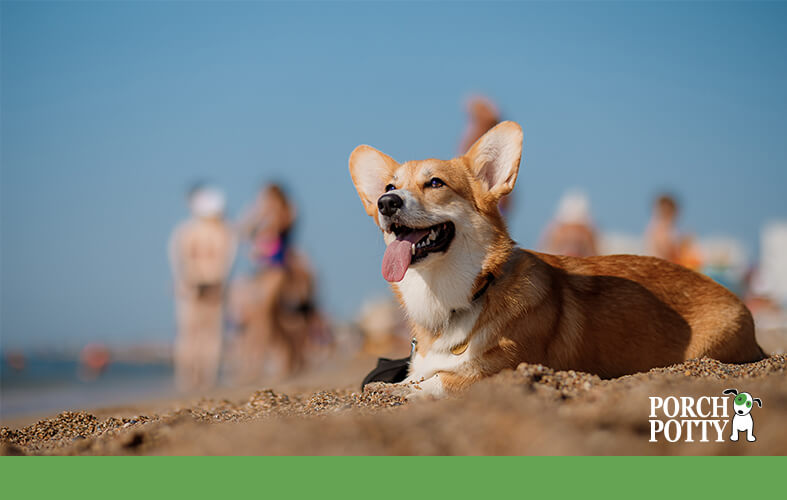
A corgi puppy soaks up the sun on the beach.
What Is Heat Stroke?
Heat stroke is when an animal’s body temperature exceeds 106°F (41°C) from an external heat source, such as a hot and sunny day. This can be a life threatening condition because when the body reaches such high temperatures, it compromises the function of vital organs, leading to organ failure and death!
Causes of Heat Stroke
It’s important to know what the causes of heat stroke are so that you can keep your furry family member safe! The most common causes of heat stroke are spending too much time outside on a hot, sunny day or leaving your pet in the car on warm days.
Spending an excessive amount of time outside on a hot day may seem like an obvious no-no, but it can be hard to tell how hot is too hot. A simple way to determine if it is too hot for your pet to be outside is by using the “seven second rule.” This involves placing the back of your hand on the asphalt for about 7 seconds. If you are not able to tolerate 7 seconds of your own hand on the asphalt, then it’s too hot for their paws!
As for the car, leaving your pet in an unattended car is never recommended, unless you are able to control the climate of your car safely while they are inside. Even still, this is not recommended because the temperature in a car elevates very quickly. For instance, when the temperature is a mere 75°F (24°C) out, in just 10 minutes the car temperature can rise to 94°F (34°C)! Often pet parents will assume that parking in the shade will remedy this problem, but that is not true! Parking in the shade has little effect on decreasing a car’s temperature, so your pet will still be susceptible to overheating. These may seem like obvious causes that can be avoided, but unfortunately heat stroke occurs quite commonly!
Additionally, certain breeds of dogs are more susceptible to heat stroke than others. Breeds with short noses that are commonly referred to as brachycephalic are predisposed to overheating. These breeds include but are not limited to bulldogs, pugs and chihuahuas. Dogs with thick fur are also at higher risk of heat stroke, such as samoyeds, huskies, pomeranians, etc. These breeds should be monitored very closely during hot summer days.

A French bulldog is enjoying a hose down with cool water to beat the heat.
Symptoms of Heat Stroke
To prevent your pet from overheating you should know the symptoms to watch out for. The symptoms of heat stroke may include but are not limited to:
- Tacky & abnormally colored gums
- Increased respiratory rate (breathing frequency)
- Excessive panting
- Drooling
- Lethargy
- Disorientation
- Seizures
- Collapse/unconsciousness
What to Do If You Suspect Your Pet Has Heat Stroke
Since heat stroke is a life-threatening condition, it is vital to take your pet to the nearest veterinary hospital immediately. In the meantime, remove your pet from the heat source; bring them inside into air conditioning. Offer your pet water. Then you can slowly start to decrease their body temperature by applying cool water or cool clothes on their paws, abdomen, and head. You should not use cold water. Additionally, a fan can be utilized to allow for them to receive cool airflow to further reduce their body temperature.
Tips to Prevent Heat Stroke
There are many ways to keep your pet nice and cool in the hot summer months and ensure that they don’t suffer from heat stroke.
- Walk your dog in the morning or evening. This keeps them out of the hot afternoon sun, but still allows them (and you!) to enjoy walks!
- Avoid pavement by walking on grass and trails. Pavement holds heat very well on hot days. Protect their paws by choosing surfaces that don’t retain as much heat like grass, gravel, and dirt.
- Protect their paws by using paw balm. This can provide a barrier between their paws and hot surfaces, but hot surfaces should still be avoided as much as possible.
- Put cooling vests/booties on your dog. Many apparel products are specifically designed for cooling pets! Usually, they work by soaking them in cool water prior to your pet wearing them, so it keeps them cool while outside.
- Use cooling mats. There are a few beds on the market that are geared towards keeping your pet cool. They are filled with water and act like a cool little waterbed!
- Purchase a kiddie pool. Many dogs love to lounge in water on a hot day. Purchasing a kiddie pool is a cost effective way to allow them to enjoy a little cool down in their very own backyard.
- Always provide access to shade and water!
- Do not muzzle your dog in the heat. The main way that dogs regulate their body temperature is by panting. When wearing a muzzle, they are not able to pant, or perhaps pant properly. This means that they won’t be able to cool themselves down, leading to overheating!

A tiny fluffy puppy drinks water out of a teal travel water bowl attached to a bottle of water.
Be sure to keep these tips in mind during warm days to keep your pooch safe from heat stroke! Remember, if you suspect your pet is suffering from heat stroke; take them to your local veterinary hospital immediately.
Jennifer Sawyer, Fourth Year Veterinary Student at Ontario Veterinary College. Jenny, or @vetstudentjenny on Instagram, has been passionate about the veterinary industry for over a decade.
For more information on keeping your puppy safe and healthy, check out these links:
Puppy Potty Training During Heatwaves: Keeping Your Puppy Comfortable and Safe




